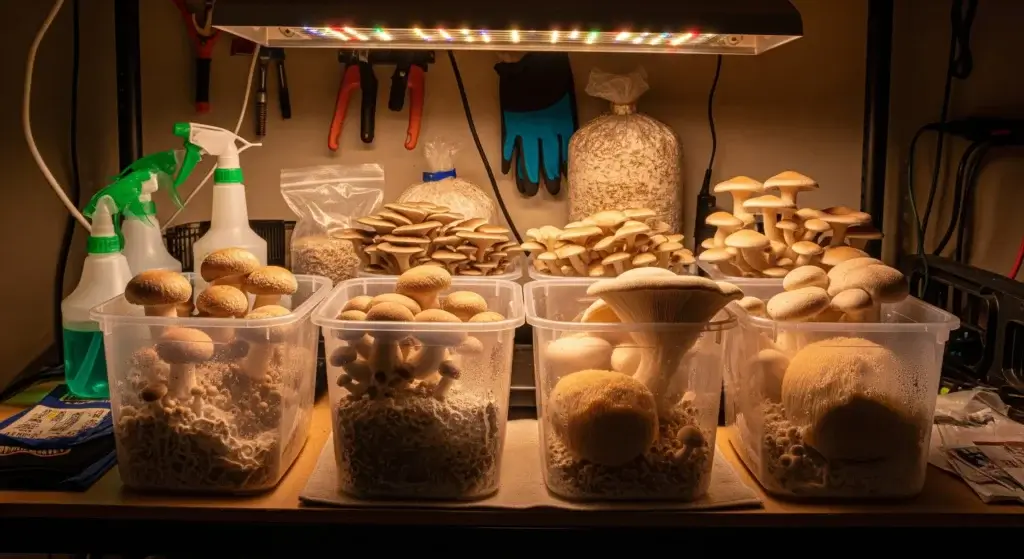
Got white powder on your plant leaves? That’s powdery mildew—super common and super annoying.
But here’s the twist: milk (yep, from your fridge) can help fight it off.
Turns out, spraying diluted milk on leaves actually works.
It’s cheap, natural, and eco-friendly—basically the TikTok hack of organic gardening.
The Science Behind Milk as a Natural Fungicide
Ever wonder how milk beats powdery mildew? It’s not magic—it’s science (kinda).
When milk hits leaves and gets some sun, proteins in it trigger a quick chemical reaction that zaps fungus spores.
Think of it like a plant-friendly bleach moment, minus the harsh vibes.
Studies back it up.
Researchers found milk spray works almost as well as sulfur fungicides—especially on cucurbits like cucumbers and squash.
One study even showed it seriously cut down on infected leaves compared to plants left alone. Simple, weird, and it actually works.
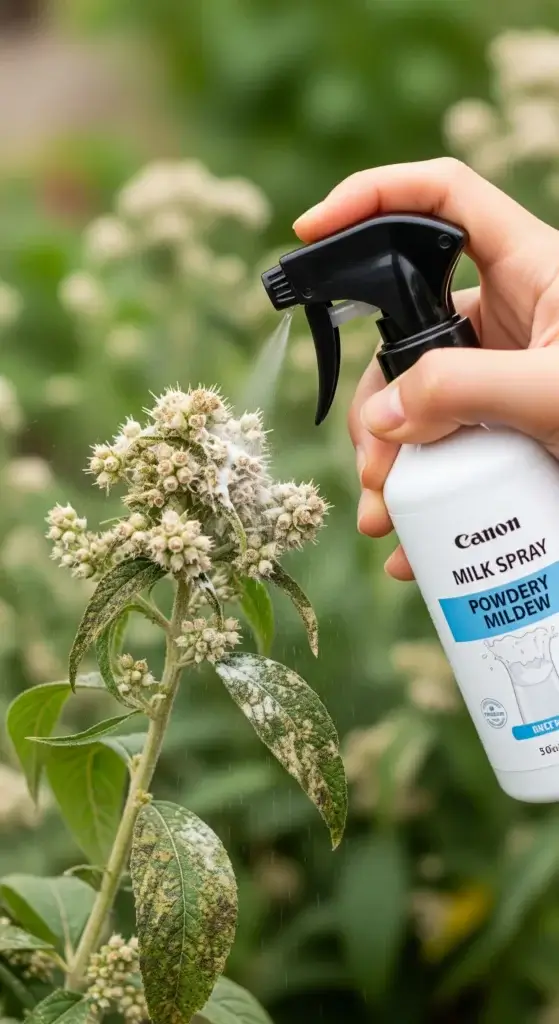
- Read also: DIY Garlic Spray for Aphids: Natural Pest Control That Works
- Read also: Homemade Onion Pest Spray: 3 Natural Recipes That Work
Why Choose Milk Spray Over Chemical Fungicides?
Let’s break it down—milk isn’t just for cereal. It’s also a solid pick for fighting powdery mildew, and here’s why:
It’s clean for the environment
- No nasty stuff: Milk doesn’t mess with bees, worms, or your soil microbes.
- Breaks down naturally: No weird leftovers in your garden beds.
- Totally organic-approved: You can use it in certified organic gardens without breaking any rules.
It’s safe for you (and everyone else)
- No gear needed: You don’t need gloves, a mask, or a hazmat suit.
- Kid and pet safe: If your dog licks the leaves or your kid touches the plant, no big deal.
- Edible plant-friendly: You can spray today and harvest tomorrow. No waiting around.
It saves you money
- Super cheap: Milk costs way less than store-bought fungicides.
- Easy to find: You probably already have it in the fridge.
- Long-lasting ingredients: Powdered or UHT milk stays good for months.
The Complete DIY Milk Spray Recipe
Milk spray is easy to make, costs almost nothing, and actually works.
Here’s the full lowdown so you don’t mess it up.
What you’ll need
- Whole milk (not skim, not almond) – 1 part
- Clean water – 2 to 3 parts (use filtered or rainwater if you can)
- Optional: A drop or two of mild liquid soap (helps it stick to leaves)
Skip ultra-pasteurized milk and all the plant-based stuff—only real dairy milk has the proteins that do the work.
How to make it
Pick the right milk
Use full-fat, fresh whole milk. This isn’t a latte—we need the proteins.
Measure it out
Mix 1 cup of milk with 2–3 cups of water. If you’re making more, just keep that 1:2 or 1:3 ratio.
Mix it well
Dump it all into a clean spray bottle or garden sprayer. Add a couple drops of soap if you want better coverage. Shake it like you mean it.
Strain it (if needed)
Using a fine sprayer? Run the mix through cheesecloth or a coffee filter so you don’t clog the nozzle.
When to use what strength
Light spray – 10% milk (1:10)
- Use for: young plants or just starting out
- How often: once a week
Standard spray – 25–33% milk (1:2 or 1:3)
- Use for: regular prevention or early signs of mildew
- How often: every 7–10 days
Stronger spray – 30% Milk (3:7)
- Use for: heavy mildew or high-risk seasons
- How often: every 5–7 days
Don’t go stronger than 30%. Too much milk = moldy leaves and unhappy plants.
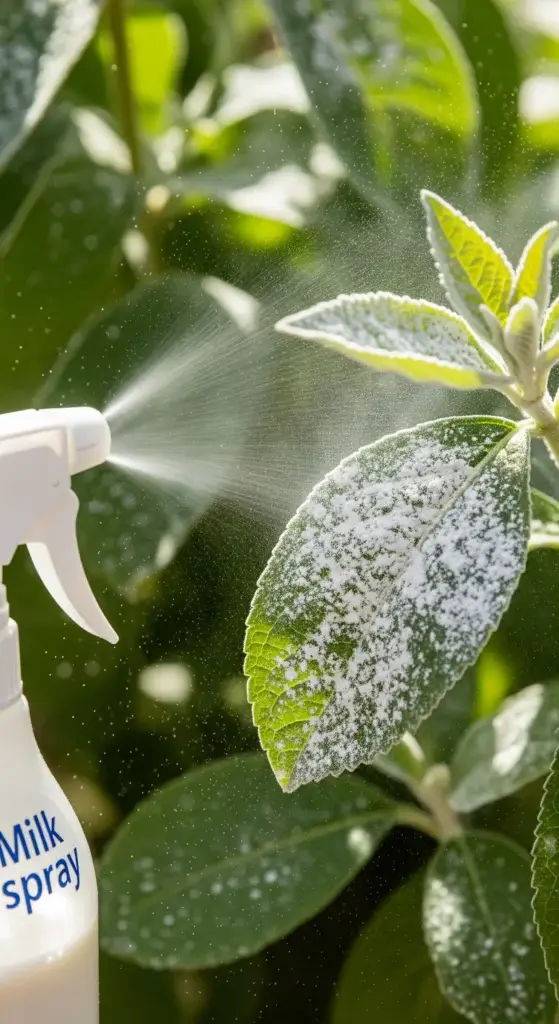
How to Apply Milk Spray Effectively
Making milk spray is easy. Using it right takes a little more effort.
Here’s how to get the most out of every spray so your plants stay mildew-free.
Timing matters
Best time to spray
Hit your plants early in the morning—when it’s cool and not too humid.
This gives the milk time to dry and do its sunlight-activated magic without turning your leaves into a fungus party.
Avoid these rookie mistakes:
- Don’t spray when it’s super hot (above 85°F / 29°C)
- Don’t spray before rain (you’ll just rinse it off)
- Skip days when humidity is sky-high (you’ll risk more mold)
How to spray like a pro
Remove the worst leaves first
If leaves are already covered in mildew, snip them off.
No point in spraying fungus you could just toss in the compost.
Spray every surface
Top, bottom, edges—get the whole leaf.
Powdery mildew loves to hide under the leaf like it’s playing hide-and-seek.
Only spray dry leaves
If your plants are wet from watering or morning dew, wait until they’re dry.
You want milk, not a milky puddle.
Use a fine-mist sprayer
Mist it evenly—think hairspray, not garden hose.
Fine droplets cover better and waste less.
Work clean
Start with healthy plants first, then move to the infected ones.
That way, you don’t spread spores from the sick to the healthy.
When and how often to spray
If you’re just preventing
Start in early summer, especially if you’ve dealt with mildew before. Spray once a week.
If your plants are already infected
Spray every 5–7 days until the mildew clears. Then switch to once a week for prevention.
During high-risk seasons
Late summer to early fall is mildew’s party season. You may need to spray more often—stick to that 5–7 day rhythm.
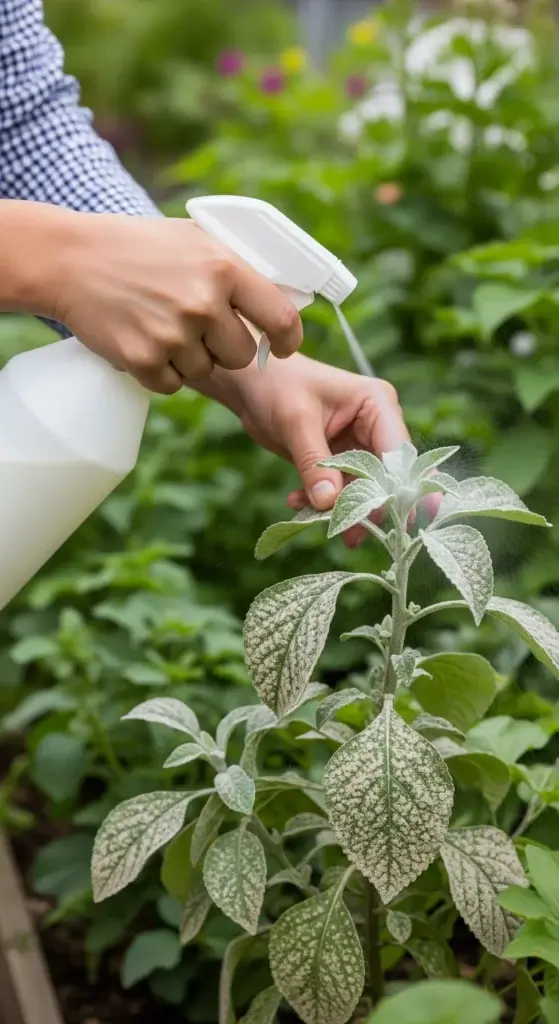
What Plants Benefit Most from Milk Spray Treatment?
Milk spray doesn’t work the same on every plant. Some love it, some are “meh,” and others need a little tweaking.
Here’s the cheat sheet:
Top performers
- Cucurbits – That’s your cucumbers, zucchini, squash, melons, and pumpkins. They respond super well.
- Roses – Classic garden drama queens, but they love milk spray for both prevention and clean-up.
- Grapes – Especially in vineyards. Powdery mildew is a big deal here, and milk helps a lot.
Works pretty well
- Tomatoes and peppers – You’ll see results, just not instant magic.
- Beans and peas – Pretty chill with it.
- Annual flowers – Like zinnias and marigolds.
- Herbs – Basil, oregano, and sage can handle it.
Handle with care
- Young seedlings – Go easy. Use a weaker mix (try 10%) so you don’t fry the baby leaves.
- Fuzzy-leaf plants – Think squash or lamb’s ear. These hold moisture, so they can get moldy if you go overboard.
- Shade lovers – Milk spray needs some sun to work. No light = no zap. Use only if they get at least a bit of sun.
Troubleshooting Common Issues
Even milk has drama sometimes. If things go sideways, here’s how to deal:
White gunk on leaves
- What’s happening: Your mix is too strong or you didn’t stir it well.
- Fix it: Dilute the milk more (try 1:3 or even 1:5) and shake that bottle like a smoothie before every use.
Mold growing on your plants
- What’s happening: You sprayed too much or did it when it was super humid.
- Fix it: Cut back on how often you spray. Wait for drier, cooler mornings.
Sprayer keeps clogging
- What’s happening: Milk solids are building up or you skipped straining.
- Fix it: Strain your mix (cheesecloth, coffee filter, whatever works). Rinse the sprayer after each use. Don’t let it sit like last week’s protein shake bottle.
It’s just not working
- What’s happening: You’re not spraying often enough, or the weather isn’t on your side.
- Fix it: Stick to a weekly schedule. Adjust based on the plant, the season, and what the mildew’s doing.
Maximizing Effectiveness: Pro Tips and Advanced Techniques
Milk spray works great—but you can level it up.
Here’s how to turn your basic mix into a mildew-fighting boss.
Boost the mix
- Add compost tea – A splash brings in good microbes that help plants fight off more than just mildew.
- Use mild soap – One drop of castile or dish soap helps the spray stick to leaves better.
- Time it right – Spray when your plants are actively growing. That’s when they soak it up best.
Don’t go solo
- Space your plants out – Better airflow = less mildew. Don’t crowd the garden like it’s a concert pit.
- Pick resistant varieties – Some plants are bred to resist mildew. Use them if you can.
- Cut the humidity – Avoid overhead watering and give your plants room to breathe.
Switch it up sometimes
Don’t use only milk forever. Swap in baking soda or neem oil now and then. It keeps fungi from getting too comfy.
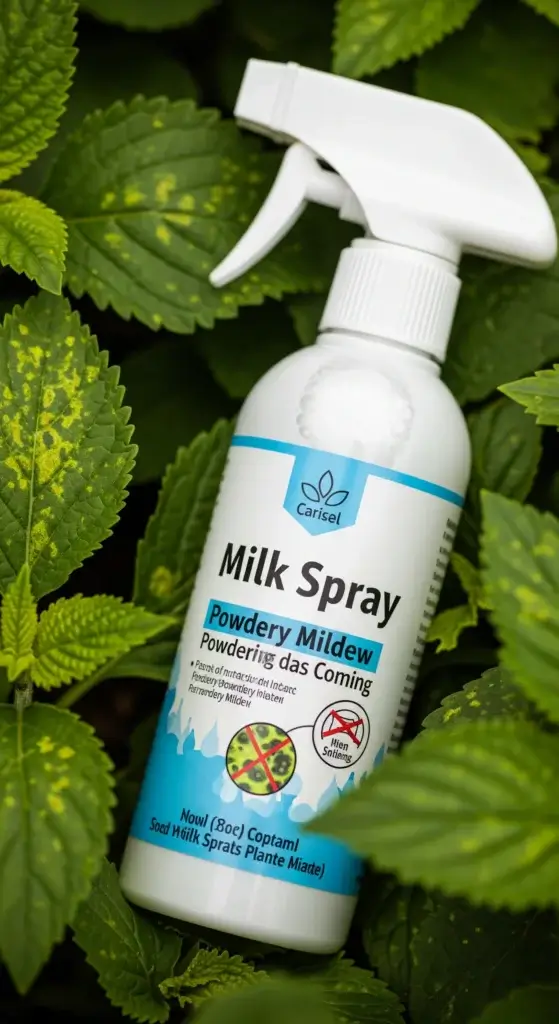
- Read also: DIY Insecticidal Soap Spray: Protect Your Plants Without Harsh Chemicals
- Read also: DIY Solution: Homemade Plant Insect Spray for a Healthy Garden
When to Seek Alternative Treatments
Milk spray is great for early-stage powdery mildew, but sometimes it just can’t keep up. If you see stuff like this:
- Mildew spreading fast, even with regular spraying
- Leaves turning yellow and dropping off
- Flowers or fruit growing weird
- Other diseases showing up too
…it’s time to call in backup.
What to try instead (or alongside milk)
- Neem oil – Smells strong, but hits hard on fungi
- Copper-based sprays – Old-school but reliable
- Biocontrols – Use friendly microbes to fight the bad ones
Conclusion: Why Milk Spray Just Works
Milk spray hits the sweet spot—it’s cheap, safe, and actually works.
It fights powdery mildew without hurting bees, pets, or your budget. And yeah, it’s backed by science.
Use it early in the season, spray consistently, and mix it with good garden habits like spacing and airflow.
It’s not just for killing mildew—it’s about growing stronger, healthier plants without reaching for harsh chemicals.

